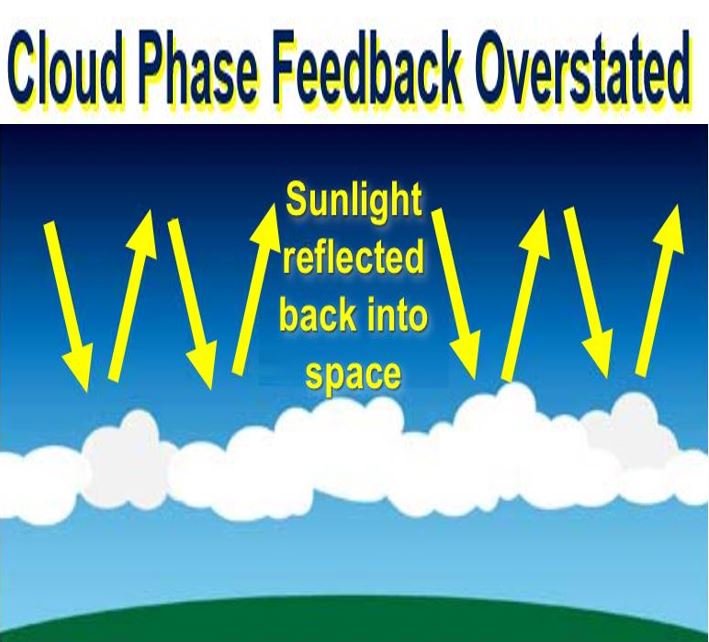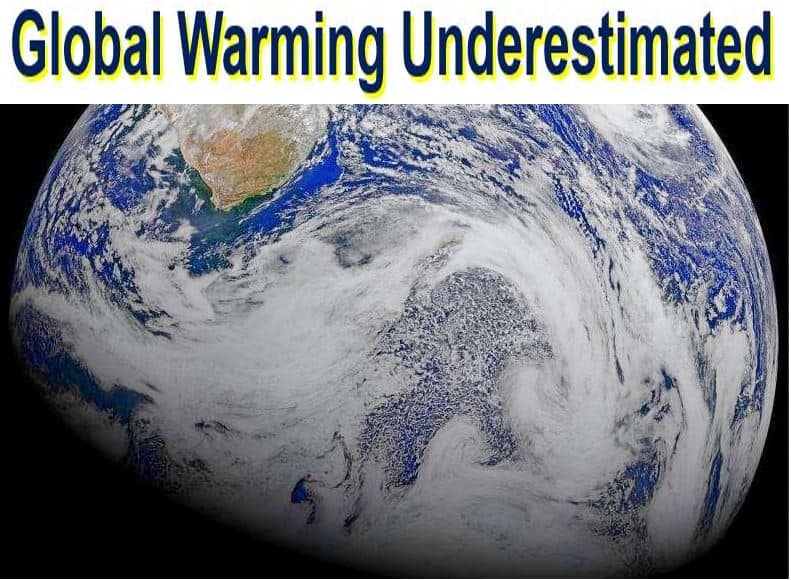Global warming is worse than most models in scientistific studies predict, because they are aggressively making clouds brighter as the Earth warms. This could be causing models to underestimate how much climate change will shift due to higher concentrations of CO2 (carbon dioxide).
Scientists at Yale University, New Haven, Connecticut, and the Lawrence Livermore National Laboratory, Livermore, California, both in the USA, wrote in the journal Science (citation below) that as the atmosphere’s temperature rises, clouds become increasingly composed of liquid instead of ice, making them brighter.
Liquid clouds reflect more sunlight back into outer space than ice clouds, which act as a brake on global warming in climate models. Global warming refers to the consistent increase in the temperature of our oceans and atmosphere.
 Most climate models had clouds reflecting too much sunlight back into space, the researchers found. (Image: climatekids.nasa.gov)
Most climate models had clouds reflecting too much sunlight back into space, the researchers found. (Image: climatekids.nasa.gov)
Models have too much light reflected back into space
However, in the majority of models, there is too much ice that is susceptible to convert into liquid with warming, which makes their stabilizing cloud phase feedback (reflecting sunlight back into space) unrealistically strong.
Using a cutting-edge climate model, Yale PhD student Ivy Tan and colleagues modified parameters to bring the relative quantities of ice and liquid in clouds into agreement with clouds observed in nature.
After correcting the bias, they found there was a weaker cloud phase feedback (less light reflected back into space) and more warming in response to CO2.
Mr. Tan, who was also lead author of the paper, said:
“We found that the climate sensitivity increased from 4 degrees C in the default model to 5-5.3 degrees C in versions that were modified to bring liquid and ice amounts into closer agreement with observations.”
 Many clouds surround the Southern Ocean. Yale and Lawrence Livermore scientists have found that climate models do not accurately portray clouds and in turn underestimate global warming. (Image: llnl.gov/news. Credit: courtesy of NASA.)
Many clouds surround the Southern Ocean. Yale and Lawrence Livermore scientists have found that climate models do not accurately portray clouds and in turn underestimate global warming. (Image: llnl.gov/news. Credit: courtesy of NASA.)
Climate sensitivity refers to how much the global mean surface temperature changes due to a doubling of CO2 levels. Climate models predict between 2.1°C and 4.7°C (3.75°F and 8.5°F) of warming in response to an increase of CO2 of 100%.
Mr. Tan explained:
“We saw a systematic weakening of the cloud phase feedback and increase in climate sensitivity as we transitioned from model versions that readily convert liquid to ice below freezing to model versions that can maintain liquid down to colder temperatures, as observed in nature.”
Co-author Trude Storelvmo, a Yale Assistant Professor of Geology and Geophysics, said:
“We saw that all of the models started with far too much ice. When we ran our own simulations, which were designed to better match what we found in satellite observations, we came up with more warming.”
Cloud’s liquid content increases as temperatures rise
In nature, clouds containing both liquid droplets and ice crystals are common at below-freezing temperatures.
As the atmosphere hots up due to CO2 emissions, the relative amount of liquid in these mixed-phase clouds will grow. As liquid clouds tend to reflect greater quantities of sunlight back into space compared to ice clouds, this phase feedback acts to mitigate global warming.
The icier the clouds at the start, the more liquid is gained as the Earth hots up; this stabilizing feedback is stronger in climate models containing less liquid in relation to ice at sub-freezing temperatures.
Co-author Mark Zelinka, a Research Scientist at the Lawrence Livermore National Laboratory’s Atmospheric, Earth and Energy Division, said regarding most climate models:
“Most climate models are a little too eager to glaciate below freezing, so they are likely exaggerating the increase in cloud reflectivity as the atmosphere warms.”
“This means they may be systematically underestimating how much warming will occur in response to carbon dioxide.”
Most models overstating cloud feedback
This latest study adds to a growing body of evidence that the stabilizing effect of cloud feedback at mid-to-high latitudes in the majority of climate models has been overstated.
Moreover, many recent studies suggest that other important cloud feedbacks are also likely to encourage global warming rather than reduce it. These include magnifying feedbacks from increases in cloud top altitude from decreases in the coverage of subtropical low clouds.
Dr. Zelinka said:
“The evidence is piling up against an overall stabilizing cloud feedback. Clouds do not seem to want to do us any favors when it comes to limiting global warming.”
This research was supported by the Regional and Global Climate Modeling Program in the Department of Energy’s Office of Science and the NASA Earth and Space Science Fellowship Program.
In an Abstract in the journal, the authors wrote:
“The higher ECS (equilibrium climate sensitivity) estimates are directly linked to a weakened cloud-phase feedback arising from a decreased cloud glaciation rate in a warmer climate.”
“We point out the need for realistic representations of the supercooled liquid fraction in mixed-phase clouds in GCMs (global climate models), given the sensitivity of the ECS to the cloud-phase feedback.”
Citation: “Observational constraints on mixed-phase clouds imply higher climate sensitivity,” Ivy Tan1, Trude Storelvmo, Mark D. Zelinka. Science. 8 April, 2016. DOI: 10.1126/science.aad5300.
Video – What is global warming?
As this Red Orbit video explains, the observed global warming on our planet is a manifestation of the Second Law of Thermodynamics.
